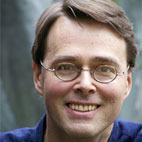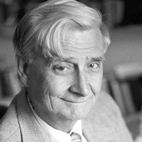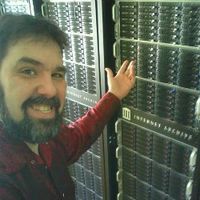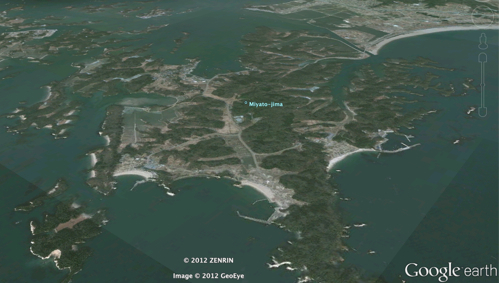Stewart Brand's Blog, page 89
May 8, 2012
Charles C. Mann Seminar Media
 This lecture was presented as part of The Long Now Foundation’s monthly Seminars About Long-term Thinking.
This lecture was presented as part of The Long Now Foundation’s monthly Seminars About Long-term Thinking.
Living in the Homogenocene: The First 500 Years
Monday April 23, 02012 – San Francisco
Video is up on the Mann Seminar page for Members.
*********************
Audio is up on the Mann Seminar page, or you can subscribe to our podcast.
*********************
Bio-blender Earth - a summary by Stewart Brand
Tumultuous effects resulted and continue to result from the massive mixing of the world’s biota when European ships reconnected the American continent to the rest of the world. Mann traced several of the cascading consequences of “the biggest ecological convulsion since the death of the dinosaurs.”
The first momentous change came from microbial exchange—20 lethal diseases came from Europe to the Americas while only one (syphilis) went the other way. North America, which had been largely cleared by natives with fire and agriculture, reforested when two-thirds to 95% of the native inhabitants died from European diseases—”the greatest demographic catastrophe in human history.” That huge reforesting drew down atmospheric carbon dioxide and Europe’s “Little Ice Age” (1550-1800) apparently resulted.
Meanwhile the mountain of silver at Potosí, Bolivia, vastly enriched Europe, which “went shopping” worldwide. Trading ships coursed the world’s oceans. One artifact picked up from Peru was the potato—a single variety of the 6,000 available. When potatoes in Europe turned out to provide four times the amount of food per acre as wheat, the previously routine famines came to an end, population soared, governments became more stable, and they began building global empires. After 1843 guano shipped by the ton from coastal Peru for fertilizer introduced high-input agriculture. In Ireland 40% of the exploding population ate only potatoes. Around 1844 a potato blight arrived from Mexico, and a million Irish died in the Great Famine and a million more emigrated.
In China, which has no large lakes and only two major rivers, agriculture had been limited to two wet regions where rice could be grown. Two imports from America—maize and sweet potato—could be farmed in dry lands. As in Europe, population went up. Vast areas were terraced as Han farmers pushed westward as far as the Mongolian desert. In heavy rains the terraces melted into the streams, and silt built up in the lowlands, elevating the rivers as much as 40 feet above the surrounding terrain, so when they flooded, millions died. “A Katrina per month for 100 years,” as one Chinese meteorologist described it. The constant calamities weakened the government, and China became ripe for foreign colonial takeover.
In America two imported diseases—malaria and yellow fever—were selective in who they killed. Europeans died in huge numbers, but Africans were one-tenth as susceptible, and so slavery replaced traditional indentured servitude in all the warm regions that favored mosquito-borne diseases. As one result, four times as many Africans as Europeans crossed the Atlantic and began mixing with the remaining native Americans, giving rise to an endless variety of racial blends and accompanying vitality throughout the Americas.
During the Q & A, Mann described a potential fresh eco-convulsion-in-waiting. “There is an area in southeast Asia roughly the size of Great Britain that is a single giant rubber plantation.” Where rubber trees originally came from in the Amazon there is now a rubber tree leaf-blight that is starting to spread in Asia. “You could lose all the rubber trees in three to six months. It would be the biggest deforestation in a long time.” The entire auto industry, he added, depends on just-in-time delivery of rubber.
Subscribe to our Seminar email list for updates and summaries.

Brian Eno to Help Judge Data Visualization Awards
Hungry for information, but bored by graphs and pie charts? Then pay a visit to Information is Beautiful, a site dedicated to all things informational – and all things pretty. Its pages showcase models and graphics that reveal what can happen when data presentation is combined with an eye for design and aesthetics.
The site is now hosting the first global award competition for data visualization, and recently announced that Long Now Board member Brian Eno has joined its panel of judges.
Along with his fellow evaluators, Eno will be reviewing submissions for awards in a variety of categories, ranging from “Interactive Visualisations” to “Data Journalism” and “Information Art.” The most prestigious award, however, is reserved – quite simply – for the “Most Beautiful” design.
Submissions are due by May 31st and they’ll announce winners at the end of July.
Check out the website for more (artfully rendered) information about the competition, and a look at the submissions; the general public gets to vote, too!

May 7, 2012
Edward O. Wilson Seminar Media
 This lecture was presented as part of The Long Now Foundation’s monthly Seminars About Long-term Thinking.
This lecture was presented as part of The Long Now Foundation’s monthly Seminars About Long-term Thinking.
The Social Conquest of Earth
Friday April 20, 02012 – San Francisco
Video is up on the Wilson Seminar page.
*********************
Audio is up on the Wilson Seminar page, or you can subscribe to our podcast.
*********************
The Real Creation Story - a summary by Stewart Brand
“History makes no sense without prehistory,“ Wilson declared, “and prehistory makes no sense without biology.” He began by noting that every religion has a different creation story, all of them necessarily based on ignorance of what really happened in the past. Religions thus can’t give valid answers on the meaning of life—Gauguin’s questions: “Where do we come from? What are we? Where are we going?” Philosophy gave up on the questions long ago. The task was left to science, and from science a valid, shareable creation story is now emerging.
For the last 65 million years Earth has been dominated by eusocial animals. Ants, termites, and bees in some areas make up half of all biomass. Yet only a few of the million known insect species made the jump to eusociality. One variety of mammal, a tiny set of primates, made a similar jump. Once they began to use their eusocial skills to fan out from Africa 60 thousand years ago, they gradually became far more dominant even than the social insects. “The term ‘eusocial,’“ Wilson said, “means a society based in part on a division of labor, in which individuals act altruistically, that covers two or more generations, and that cares for young cooperatively.”
That eusociality is so rare suggests how difficult it is for altruistic traits to evolve. The powerful evolutionary force to make individuals that successfully reproduce has to be overcome by some form of selective pressure which generates altruistic individuals who yield their interests to the interests of the group. How does that occur? Examining near-eusocial species like African wild dogs and snapping shrimp along with primitively eusocial species like sweat bees shows that a crucial step appears to be made when multiple generations linger to defend a constructed nest with valuable access to food. That step can be made with a simple change to a single behavioral gene, silencing the trait for normal dispersal of young to carry out their own independent reproduction. When the young linger to defend the nest and begin to provide for the next generation of young, eusociality begins.
All eusocial species appear to have arisen from multi-generational nest defense. Two million years ago our ancestors began using fire for campsites and cooking. At the same time hominid brain size began expanding dramatically. Social traits emerged that have characterized humanity ever since. We love joining groups, and we became geniuses at reading the intentions of each other, a skill we fine-tune incessantly with our enjoyment of gossip. In another distinctively human trait, like ants, we became highly adept at collaborative warfare.
Wilson had long been a proponent of William Hamilton’s theory of “kin selection” as an explanation for how altruistic traits could evolve. But as a naturalist he found it did not explain phenomena that he and others were discovering in eusocial species, and he began to favor “group selection” instead—a process where the “target” of evolution was sacrificially collaborative traits, because highly cooperative groups beat poorly cooperative groups, and the “units” of evolution (genes) adjusted accordingly. It is successful groups, more than successful families, that are being selected for. In 2010 Wilson, along with mathematician Martin Nowak and Corina Tarnita formally challenged kin selection with a peer-reviewed paper in Nature. There was, as Wilson put it, “considerable blowback” from kin selection theorists and supporters.
Wilson’s alternative he calls “multi-level selection,” where individual selection and group selection proceed together (with kin selection a continuing bit player). In our eusocial species, that mix of traits makes us “permanently unstable, permanently conflicted” between selfish impulses and cooperative impulses. We negotiate these conflicts endlessly within ourselves and with each other. Wilson sees inherent adaptive value in that constant negotiation. Our vibrant cultural life may be driven in part by it.
In response to a question about what the next stages of human eusociality might be, Wilson said he hoped for a fading of interest in end-state ideologies and end-time religious creation stories because they so fervently deny negotiation.
Subscribe to our Seminar email list for updates and summaries.

May 3, 2012
Charles C. Mann Seminar Media
 This lecture was presented as part of The Long Now Foundation’s monthly Seminars About Long-term Thinking.
This lecture was presented as part of The Long Now Foundation’s monthly Seminars About Long-term Thinking.
Living in the Homogenocene: The First 500 Years
Monday April 23, 02012 – San Francisco
Audio is up on the Mann Seminar page, or you can subscribe to our podcast.
*********************
Bio-blender Earth - a summary by Stewart Brand
Tumultuous effects resulted and continue to result from the massive mixing of the world’s biota when European ships reconnected the American continent to the rest of the world. Mann traced several of the cascading consequences of “the biggest ecological convulsion since the death of the dinosaurs.”
The first momentous change came from microbial exchange—20 lethal diseases came from Europe to the Americas while only one (syphilis) went the other way. North America, which had been largely cleared by natives with fire and agriculture, reforested when two-thirds to 95% of the native inhabitants died from European diseases—”the greatest demographic catastrophe in human history.” That huge reforesting drew down atmospheric carbon dioxide and Europe’s “Little Ice Age” (1550-1800) apparently resulted.
Meanwhile the mountain of silver at Potosí, Bolivia, vastly enriched Europe, which “went shopping” worldwide. Trading ships coursed the world’s oceans. One artifact picked up from Peru was the potato—a single variety of the 6,000 available. When potatoes in Europe turned out to provide four times the amount of food per acre as wheat, the previously routine famines came to an end, population soared, governments became more stable, and they began building global empires. After 1843 guano shipped by the ton from coastal Peru for fertilizer introduced high-input agriculture. In Ireland 40% of the exploding population ate only potatoes. Around 1844 a potato blight arrived from Mexico, and a million Irish died in the Great Famine and a million more emigrated.
In China, which has no large lakes and only two major rivers, agriculture had been limited to two wet regions where rice could be grown. Two imports from America—maize and sweet potato—could be farmed in dry lands. As in Europe, population went up. Vast areas were terraced as Han farmers pushed westward as far as the Mongolian desert. In heavy rains the terraces melted into the streams, and silt built up in the lowlands, elevating the rivers as much as 40 feet above the surrounding terrain, so when they flooded, millions died. “A Katrina per month for 100 years,” as one Chinese meteorologist described it. The constant calamities weakened the government, and China became ripe for foreign colonial takeover.
In America two imported diseases—malaria and yellow fever—were selective in who they killed. Europeans died in huge numbers, but Africans were one-tenth as susceptible, and so slavery replaced traditional indentured servitude in all the warm regions that favored mosquito-borne diseases. As one result, four times as many Africans as Europeans crossed the Atlantic and began mixing with the remaining native Americans, giving rise to an endless variety of racial blends and accompanying vitality throughout the Americas.
During the Q & A, Mann described a potential fresh eco-convulsion-in-waiting. “There is an area in southeast Asia roughly the size of Great Britain that is a single giant rubber plantation.” Where rubber trees originally came from in the Amazon there is now a rubber tree leaf-blight that is starting to spread in Asia. “You could lose all the rubber trees in three to six months. It would be the biggest deforestation in a long time.” The entire auto industry, he added, depends on just-in-time delivery of rubber.
Subscribe to our Seminar email list for updates and summaries.

April 30, 2012
Slow Motion Car Crash
It’s somewhere between performance and installation art: last month, artist Jonathan Schipper slowly – and deliberately – crashed a car into a wall. Moving at microscopic speeds, the crash took place over the course of a full month, each day inching a bit closer to its inevitable fate.
Schipper’s piece captures the destruction of speed, precisely by taking ‘speed’ out of the equation. He explains that
“We stop and look at a car wreck to reacquaint ourselves with the lost velocity, to reconnect with cause and effect. For we live increasingly in a world without effect, without impact. Speed changes meaning, changes the effects of catharsis.”
By isolating ‘effect’ and putting it on display, Schipper reminds us that life, and the things we do, make an impact on the world around us. He has created a piece of art that takes the long term not only as its medium, but as its message as well.

April 26, 2012
Susan Freinkel Seminar Tickets
Seminars About Long-term Thinking

Susan Freinkel on “Eternal Plastic: A Toxic Love Story”
TICKETS
Tuesday May 22, 02012 at 7:30pm Cowell Theater at Fort Mason
Long Now Members can reserve 2 seats, join today! • General Tickets $10
About this Seminar:
Plastic now pervades civilization—how many of the things you see from where you are right now are plastic? It is an ingenious material whose miraculous qualities we take too much for granted, but it also sometimes has nightmarish downstream effects. The giant polymer molecules (polyethylene, polypropylene, polystyrene, etc.) that are so marvelously cheap to mold, extrude, shape, and weave are also extremely durable. Their cheapness makes them the basic material of a throw-away culture (one third of all plastic goes into disposable packaging.) Their durability means that any toxic effects persist indefinitely in the environment.
Plastic presents a problem in temporal management of the very long-term and the very short-term. How do we get the benefits of plastic’s amazing durability while reducing the harm from its convenient disposability? The matter requires close and respectful coordination between short-term experts (businesses) and long-term experts (governments and nonprofits). Managing plastic well is a microcosm of managing civilization well.
Susan Freinkel is the author of Plastic: A Toxic Love Story and American Chestnut: The Life, Death, and Rebirth of a Perfect Tree.

April 25, 2012
Edward O. Wilson Seminar Media
 This lecture was presented as part of The Long Now Foundation’s monthly Seminars About Long-term Thinking.
This lecture was presented as part of The Long Now Foundation’s monthly Seminars About Long-term Thinking.
The Social Conquest of Earth
Friday April 20, 02012 – San Francisco
Audio is up on the Wilson Seminar page, or you can subscribe to our podcast.
*********************
The Real Creation Story - a summary by Stewart Brand
“History makes no sense without prehistory,“ Wilson declared, “and prehistory makes no sense without biology.” He began by noting that every religion has a different creation story, all of them necessarily based on ignorance of what really happened in the past. Religions thus can’t give valid answers on the meaning of life—Gauguin’s questions: “Where do we come from? What are we? Where are we going?” Philosophy gave up on the questions long ago. The task was left to science, and from science a valid, shareable creation story is now emerging.
For the last 65 million years Earth has been dominated by eusocial animals. Ants, termites, and bees in some areas make up half of all biomass. Yet only a few of the million known insect species made the jump to eusociality. One variety of mammal, a tiny set of primates, made a similar jump. Once they began to use their eusocial skills to fan out from Africa 60 thousand years ago, they gradually became far more dominant even than the social insects. “The term ‘eusocial,’“ Wilson said, “means a society based in part on a division of labor, in which individuals act altruistically, that covers two or more generations, and that cares for young cooperatively.”
That eusociality is so rare suggests how difficult it is for altruistic traits to evolve. The powerful evolutionary force to make individuals that successfully reproduce has to be overcome by some form of selective pressure which generates altruistic individuals who yield their interests to the interests of the group. How does that occur? Examining near-eusocial species like African wild dogs and snapping shrimp along with primitively eusocial species like sweat bees shows that a crucial step appears to be made when multiple generations linger to defend a constructed nest with valuable access to food. That step can be made with a simple change to a single behavioral gene, silencing the trait for normal dispersal of young to carry out their own independent reproduction. When the young linger to defend the nest and begin to provide for the next generation of young, eusociality begins.
All eusocial species appear to have arisen from multi-generational nest defense. Two million years ago our ancestors began using fire for campsites and cooking. At the same time hominid brain size began expanding dramatically. Social traits emerged that have characterized humanity ever since. We love joining groups, and we became geniuses at reading the intentions of each other, a skill we fine-tune incessantly with our enjoyment of gossip. In another distinctively human trait, like ants, we became highly adept at collaborative warfare.
Wilson had long been a proponent of William Hamilton’s theory of “kin selection” as an explanation for how altruistic traits could evolve. But as a naturalist he found it did not explain phenomena that he and others were discovering in eusocial species, and he began to favor “group selection” instead—a process where the “target” of evolution was sacrificially collaborative traits, because highly cooperative groups beat poorly cooperative groups, and the “units” of evolution (genes) adjusted accordingly. It is successful groups, more than successful families, that are being selected for. In 2010 Wilson, along with mathematician Martin Nowak and Corina Tarnita formally challenged kin selection with a peer-reviewed paper in Nature. There was, as Wilson put it, “considerable blowback” from kin selection theorists and supporters.
Wilson’s alternative he calls “multi-level selection,” where individual selection and group selection proceed together (with kin selection a continuing bit player). In our eusocial species, that mix of traits makes us “permanently unstable, permanently conflicted” between selfish impulses and cooperative impulses. We negotiate these conflicts endlessly within ourselves and with each other. Wilson sees inherent adaptive value in that constant negotiation. Our vibrant cultural life may be driven in part by it.
In response to a question about what the next stages of human eusociality might be, Wilson said he hoped for a fading of interest in end-state ideologies and end-time religious creation stories because they so fervently deny negotiation.
Subscribe to our Seminar email list for updates and summaries.

April 18, 2012
Esther Dyson on Charter Cities
In a recent article on Slate, Long Now Board member Esther Dyson takes up the concept of Charter Cities – Paul Romer’s model for the creation of prospering, sustainable zones of urban life, about which he spoke at a 02009 SALT lecture. Dyson suggests that Romer’s business-model approach to the construction and functioning of urban centers could work not only for new cities, but for old ones as well.
Cities already behave a bit like corporations, she writes. With greater flexibility and open borders, cities can compete for “customers” in a way that countries cannot, and are more directly involved in the daily lives of citizens. Dyson argues that a little more market-style competition can compel existing metropolises to improve their infrastructure and resources as a way to attract potential citizens. This investment will pay off in the form of flourishing residents, who in turn will bring in additional resources and allow the city to prosper. On a larger scale, a prospering city will then compel its neighboring towns to improve their own functioning as well, to become better competitors on the market of citizens and resources.
In the end, it’s all about the long view: it’s about encouraging civilization to prosper as a whole. Cities are an appropriate unit of civilization to work with, Dyson writes, because they have shown more long-term stability than countries or empires:
“Most cities have grown, through evolution, from unpremeditated beginnings. Moreover, they rarely die. Cities (and their imperfections) persist in a way that large political entities, even those of which they are a part, do not. Compare, say, Athens, Jerusalem, Vienna, Beijing, Moscow, or Istanbul, to the Roman Empire, Austria-Hungary, the Ottoman Empire, Imperial Russia, the Third Reich, or the Soviet Union. And, as we are seeing worldwide nowadays, national governments are difficult to overturn and also difficult to (re)build. Democracy does not always lead to liberty or good outcomes. So, perhaps cities are the right place and have the right scale for massive social change.”

April 16, 2012
Rogue Archivists Fight the Digital Dark Age
Vigilantes? Internet Archaeologists? Digital doomsday sayers?
The Archive Team has been called many things. Here at Long Now we’ve been following their work, which was recently featured by NPR’s On The Media. In a brief interview for the program, founder Jason Scott talked about some of the work they’re doing, and why it’s important.
Scott describes his group as a kind of emergency response team that comes into action whenever a social media site shuts down. We share our personal lives on these sites by uploading pictures, music, and other materials through their free services. But, Scott warns, such platforms are inherently fragile and short-lived – and what happens to our stuff when they’re taken down?
“People put their lives online, and then one day wake up and realize, it’s not there anymore. They are keeping their memories on spinning magnetic pieces of metal.”
That’s where the Archive team comes in. “We’ve been compared to firemen,” Scott says: they enter doomed sites and “try to grab what [they] can,” hoping to salvage the photos, writings, and other memories people had stored there.
An ambitious goal – but it does prompt a question: is everything we upload to the net really worth saving? Isn’t most of it a sea of insignificant snapshots and mundane memories? Scott counters that even the most trivial piece of information may harbor a nugget of historical gold:
“… the example that I give is a civil war letter to a wife from her husband who is on the front lines. It might be the most trivial thing to say, ‘hope the cows are OK, hope you’re fine,’ but there’s so much other information coded in there. There could be a watermark showing that a company that said it never worked for that side, did in fact sell paper to that side. It could be a certain kind of ink, it could be that that one front guy became a general, and this is one of the few cases of him signing his own name. I know it’s a stretch, but there are people right now, taking some of the things we download, and doing cultural analysis. This is what happened when life went online. This is what happened when people reached a larger audience than their genetic line had ever reached. What did they do, given that power? And so, even though we might objectively say, this is trivial, I wouldn’t want these read out to me, one by one, forever, everything historical that we see is because a whole line of people said, ‘let’s not throw out that box’, let’s not delete that tape, let’s not get rid of those pictures. And, I don’t want to be the guy who decided, ok, this is good, this is bad, and then 100 years later be hated.”
In other words, even the tiniest tweet could give future generations some crucial insight into the workings of 21st century culture. The Archive Team is here to save it all from being swallowed by the digital dark age, one site at a time.

April 11, 2012
Ancient Legend Saves Lives of Descendants
Sometimes technology fails – but luckily, collective memory can step in to lend a hand.
In a recent LA Times article, José Holguín-Veras writes about an old legend that saved a small island community in Japan from perishing in the tsunami that followed the earthquake of March 02011. The quake had toppled their tsunami warning system, but when villagers saw the approaching waters, a lesson passed down from their ancestors told them what to do.
"A millennium ago, the residents of Murohama, knowing they were going to be inundated, had sought safety on the village's closest hill. But they had entered into a deadly trap. A second wave, which had reached the interior of the island through an inlet, was speeding over the rice paddies from the opposite direction. The waves collided at the hill and killed those who had taken refuge there. To signify their grief and to advise future generations, the survivors erected a shrine."
1,000 years later, those descendants knew not to make the same mistake, and bypassed the hill in favor of higher ground a bit further away.
We've written before about ancient tsunami warning systems in Japan, as examples of long-term thinking that helped communities learn from lessons of the past. The work of these Japanese ancestors illustrates the value of preserving our collective knowledge for the good of the future – and reminds us that local culture itself can be a durable archive of wisdom.

Stewart Brand's Blog
- Stewart Brand's profile
- 291 followers








